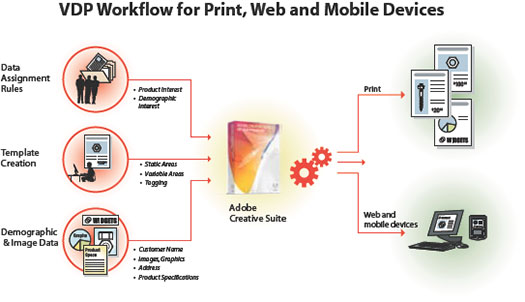Imagine shooting 1 or 100,000 arrows from a single bow simultaneously and having each one hit its intended, separate target — right in the bull’s-eye. That’s the idea behind Variable Data Publishing (VDP), and why so many people believe in its power to create marketing campaigns that produce excellent results.
VDP automates the creation of customized materials by merging recurring content from a page layout template with variable data imported from a database and digital asset repository. Dynamic design software assembles each unique document according to a set of rules defined by the user, and an advanced digital publishing system produces a final piece in which text, graphics, and imagery are as individual as each recipient.
Elements of a VDP workflow

VDP standard languagesTo achieve optimum results, VDP suppliers — from database, to design, to output — must integrate their technologies with highly collaborative workflows. The key to integrating these solutions is the availability of VDP products and technologies that are based on industry standards, including Adobe Portable Document Format (PDF), Adobe PostScript®, Extensible Markup Language (XML), and Job Definition Format (JDF). This helps ensure the broadest possible set of options to the end user and the most flexible basis of collaboration for providers.
JDF: Adobe is the first to tie JDF from desktop to output with Creative Suite, improving workflow automation, speed, and predictability.
PDF: A worldwide industry-standard file format developed by Adobe.
PDF/VT (V=Variable; T=Transactional): An emerging ISO standard for exchanging VDP jobs.
PostScript: A worldwide industry-standard page description language developed by Adobe.
Personalized Print Markup Language (PPML): An XML-based markup language for variable data printing.
XML: A markup language for creating documents that specifies a standard way to organize, tag, and deliver content.
